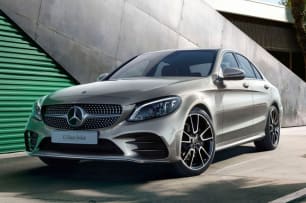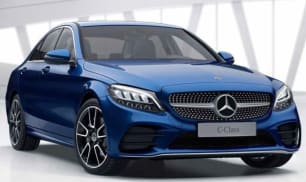There has been a philosophical shift in how the C-Class is presented.
Even with their standard-in-Australia AMG Line package, the regular grades like the C200 and C300 are now leaning into the brand's luxury heritage, while the BMW-baiting sports sedan versions will be left to the coming AMG versions.
And this in turn profoundly informs how the W206 drives.
Even with the optional Sports Pack on 19-inch wheels, the C200 as tested finally feels like a premium midsized sedan experience. Muted at start up, the 150kW/300Nm 1.5L turbo steps off the line smartly and smoothly, its nine-speed auto shifting effortlessly through the gears to keep the engine feeling lively and lusty.
Around town it's easy to mistake the engine as a larger-capacity unit, since throttle response is instantaneous, with little to no lag detectable. It's a strong start for a base powertrain, especially as the C200 settles into a relaxed cruise at freeway speeds. Cycling through the driving settings also reveals how feisty the 'Sport' mode is.
But the 1.5L's lack of size becomes obvious the moment you need to overtake quickly, or when a quick squirt of acceleration up a hill is required, because the engine needs plenty of revs to approach that 6100rpm power peak. While still pretty brisk in these situations, it's also fairly vocal too, with a sense of having to work hard to maintain momentum.
Switching to the C300 highlights how much better suited the 190kW/400Nm 2.0L turbo is to highway driving, leaping forward with much more force and conviction, across the entire performance spectrum. In every metric, this is a better choice – throttle response, mechanical refinement, cruising ease. And the fact that the onboard computer showed less fuel consumption cements our preference for the larger-hearted C-Class.
In fact, both models possess a chassis that feels like it could do with a whole lot more power. Light and tight around town, the steering weighs up nicely at higher speeds, with a linear and reassuringly planted feel. The same also applies to how confident and controlled the Mercedes feels through fast, tight turns, yet settles into a relaxed and comfortable tourer along long, straight stretches of road.
It's a pity, then, that such dynamic agility and prowess doesn't really involve the driver, since the steering feels quite isolated from what's going on underneath; for the vast majority of C-Class buyers, that's fine. But, as a quick spin in any latest BMW 3 Series or Jaguar XE will reveal, there isn't an intimate, two-way connection going on here. That's probably going to be reserved for the AMG models.
Our C200 rode on bigger wheels and steel springs, while the C300 was fitted with optional adaptive dampers. In the previous-generation C-Class, the differences would be stark: a busy and jittery ride in the former, compared to soft yet still unsettled suspension in the latter.
That's all ancient history now, as even the 'passively' suspended C200 now isolates its occupants from the rough and tumble of our inconsistent roads. Still firmish, but no longer harsh.
And the C300 with adaptive dampers seems downright plush by comparison, while offering the driver personalisation options within the aforementioned driving models to tailor the steering, performance and engine sound settings that best suit the prevailing mood.
Too bad there's some road and tyre noise intrusion heard inside when driving over coarse bitumen roads. This is a common pitfall amongst German vehicles in Australia.
Still, it doesn't detract from the fact that the whole chassis set-up can at-last cushion and cosset occupants like, well, a mini S-Class.
Which is the whole point of the W206 C-Class. It now majors on comfort and reassurance like the better Mercedes-Benz models used to, while still being suave and sprightly enough to be a memorable – if not over-exciting – drive.
As a result, the C300 especially is a much-more likeable car than past iterations. Just remember to tick the adaptive damper option for the most optimal experience. Job well done, Mercedes.







